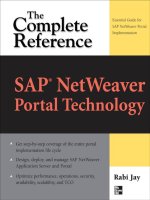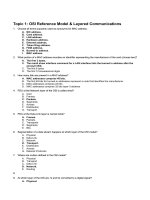The OSI Reference Model
Bạn đang xem bản rút gọn của tài liệu. Xem và tải ngay bản đầy đủ của tài liệu tại đây (142.87 KB, 11 trang )
5
The OSI Reference Model
5.1 Reasons for Standardization
The Open System Interconnection (OSI) Reference Model was specified
by ITU, in cooperation with ISO and IEC, and is documented in Recommen-
dation X.200. Although the OSI model is applicable in many areas, it is
used mostly in the area of communication between computers. Its purpose is to
organize and formalize the communication method.
The basic idea of the OSI Reference Model is to separate the various parts
that, in their totality, form a communications process. Separation of concerns is
achieved by layering and modularization of transactions and tasks. This
approach results from the following reasoning:
•
The use of microprocessors in telecommunications not only allowed
for the creation of new services, but at the same time increased the
requirements on communications of exchanges and computers.
•
When humans communicate by means of telephone or letters, they do
not want to be concerned with the details of the physical transfer of
the information. They just want to communicate. The same applies
to the layers of the OSI Reference Model, in which each layer has a
fixed role in the process of communications.
•
A computer is a modular structure, which starts with the transistor on
the lowest level and, with modularity built on top of modularity, ends
up as a super-computer. To use such a system becomes easier when the
tasks themselves can be modularized.
39
•
Telephone systems are used for many applications. These applications
became possible only because the application itself had become more
independent of the process of pure data transmission. Modems and fax
machines, for instance, rely on the functionality of the services of a
lower layer and adapt their own functionality accordingly. The tele-
phone network, on the other hand, is not concerned with the content
or the representation of the transmitted data.
•
The OSI Reference Model enables two products from different
manufacturers to communicate. Many interworking problems cannot
be solved simply by the interface specification shown in Figure 5.1.
Each telephone set and every exchange can be regarded as network ele-
ment A, B, or C. If, for example, the manufacturer of one network
element implements all the functionality of a particular application
and the second manufacturer implements only those functions that are
necessary for a particular task, then, generally speaking, the two devices
cannot be interconnected.
5.2 Layering in the OSI Reference Model
The OSI Reference Model breaks down or separates the communication
process into seven independent layers. The following are the general “rules” of
the OSI model:
•
Two layers that lie above each other work independently. Each layer
receives a service from the layer immediately below and provides a
service to the layer immediately above. The lower layer does not care
40 GSM Networks: Protocols, Terminology, and Implementation
Physical layer
Data link layer
Network layer
Network node A
Network node CNetwork node B
Peer-to-peer protocol (e.g., ISUP, SCCP)
Physical layer
Data link layer
Network layer
Transport layer
Session layer
Presentation layer
Application layer
7
6
1
2
3
4
5
Physical layer
Data link layer
Network layer
Transport layer
Session layer
Presentation layer
Application layer
7
6
1
2
3
4
5
Primitives
Primitives
Figure 5.1 The layers and message types of the OSI Reference Model.
about the content of the received information. Consider the analogy of
sending mail. The post office is not concerned about the content of a
letter, which it has received to deliver. Its only concern is the address
on the envelope, which it follows in order to make the delivery. This
constitutes a service, which is independent of the contents of the letter.
•
Each layer communicates directly only with the layers immediately
below and above itself and indirectly with its peer layer at the remote
end. Let us again refer to the post office analogy. Neither the sender
nor the addressee is concerned about the details of the service, that is,
about how the letter is routed, and neither the sender nor the addressee
needs to communicate with the letter carrier. They only need to have
access to a mailbox. The two parties communicate with each other by
writing or reading the letter.
•
If a communications process involves more than two network nodes,
the intermediate network node or nodes need only provide the func-
tionality of Layers 1 through 3. As Figure 5.1 shows, network node B
is equipped only with Layers 1, 2, and 3. Layers 4 through 7 are
required at the end points of a connection only. Going back to the let-
ter delivery example, in this “communications process” all post offices
and postal workers are involved only in transport and error-free deliv-
ery of the letter. All other parts of the communication process are avail-
able only at the sender and receiver sides.
•
The protocols used for Layers 1 through 3 on the interface between A
and B are not necessarily the same as those used on the interface
between B and C. For example, Layer 2, between the BTS and the
BSC in GSM, uses the LAPD protocol, while the SS7 protocol is used
between the BSC and the MSC. In that case, network node B would
represent the BSC.
5.3 Data Types of the OSI Reference Model
All messages exchanged between Layer N and Layer (N − 1) are called primi-
tives. In practical work, except for measurements within a network element,
there usually is no need to become involved in the inner workings of the primi-
tives, it suffices to know that they exist and to have an idea of their function.
All message exchange on the same level (or layer) between two network
elements, A and B, is determined by what is known as peer-to-peer protocol.
Consequently, all messages that can be seen on any GSM interface between two
nodes belong to the group of peer-to-peer protocols.
The OSI Reference Model
41
5.4 Information Processing in the OSI Reference Model
The tasks of the Layers 7 down to 2 mainly are to add processing information.
When, for example, Layer 6 receives a primitive from Layer 7, it adds header
information, which allows the “partner” layer on the other end to process the
received data according to the appropriate peer-to-peer protocol. The partner
layer is responsible for removing the header information. Figure 5.2 illustrates
the relationship. The obvious result is the increase in the data that needs to be
transmitted.
5.5 Advantages of the OSI Reference Model
The major advantage of the OSI Reference Model lies in the fact that the
various layers are independent of each other. What does independence in this
context mean? It means that Layer N shares a common protocol with its peer
Layer N and with the layers immediately above and below it but not with
any other layers. The OSI Reference Model defines only the interface between
them and not the way a certain layer is implemented. Therefore, it is, for exam-
ple, irrelevant to a large degree how the physical signal transmission is achieved.
The transmission medium used for the data transfer may be cable, direct radio,
satellite, or any other appropriate means.
That permits the design and use of modules on a general level, a state-
ment that has to be tempered by the actual application. It certainly matters,
42 GSM Networks: Protocols, Terminology, and Implementation
77
66
11
22
33
44
55
User data User data
Header Header
77
2 2
55
33
4
4
7
7
7 7
6
6
7
7
6
5
5
6 6
6 6
6 6
55
55
55
7 7
7 7
7 7
44
44
44
33
33
22
6
5
7
4
3
2
Physical layer
Data link layer
Network layer
Transport layer
Session layer
Presentation layer
Application layer
6
6
6
Figure 5.2 Data flow in the OSI Reference Model.
with respect to the propagation delay, whether transmission is via cable or satel-
lite, where the propagation delays may be substantial.
5.6 The Seven Layers of the OSI Reference Model
5.6.1 Layer 1: The Physical Layer
The Physical Layer is responsible for the actual transmission of the data and the
provision of the necessary facilities. The facilities can be, for example, a copper
wire, a satellite connection, direct radio, or an optical fiber. The Physical Layer
may include some synchronization features that do not have any significance
for the higher layers, since those features are purely hardware related. Examples
of such features are the clear-to-send (CTS) signal and the ready-to-send (RTS)
signal of the serial interface on a computer (COM-Port).
Layer 1 does not know data types or data formats and is not able to distin-
guish between control data and user data. That characteristic, in particular,
distinguishes Layer 1 from the other layers. The data packets received from
Layer 2 are transmitted without additional verification. Each data packet con-
sists of either a single bit or a number of bits.
With regard to the Air-interface of a GSM system, the GMSK modula-
tion and the HF equipment in the MS and the BTS are part of Layer 1. Over
the terrestrial interfaces, the PCM, including signal levels and propagation
delays, is part of Layer 1.
Naturally, the implementation of the Physical Layer depends greatly
on the type of interface and might change frequently. For example, between
the BTS and the BSC, Layer 1 might be implemented as microwave transmis-
sion on the first section, as optical fiber on a second section, and as plain cable
on a third section.
5.6.2 Layer 2: The Data Link Layer
The Data Link Layer is responsible for the packaging of the data to be transmit-
ted. The data are combined into packets or frames and then handed to the
Physical Layer for synchronous or asynchronous transmission. A widespread
method for such framing is the high-level data link control (HDLC) protocol,
which provides a general structure for data frames and forms, which is the basis
for the SS7 protocol as well as for the LAPD protocol. The Glossary provides a
description of the HDLC frame format.
The main purpose of all the tasks of Layer 2 is that of error detection and
correction. Data frames are formed by introducing start/stop marks and by
The OSI Reference Model
43









